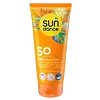What's inside
What's inside
 Key Ingredients
Key Ingredients

 Benefits
Benefits

 Concerns
Concerns

 Ingredients Side-by-side
Ingredients Side-by-side

Water
Skin ConditioningDibutyl Adipate
EmollientGlycerin
HumectantDiethylamino Hydroxybenzoyl Hexyl Benzoate
UV FilterC12-15 Alkyl Benzoate
AntimicrobialEthylhexyl Salicylate
UV AbsorberEthylhexyl Triazone
UV AbsorberBis-Diglyceryl Polyacyladipate-2
EmollientPotassium Cetyl Phosphate
EmulsifyingBis-Ethylhexyloxyphenol Methoxyphenyl Triazine
Skin ConditioningCopernicia Cerifera Cera
EmollientHydrogenated Palm Glycerides
EmollientTocopheryl Acetate
AntioxidantPhenylbenzimidazole Sulfonic Acid
UV AbsorberHydroxyacetophenone
AntioxidantOryza Sativa Bran Cera
Skin ConditioningSqualane
EmollientMicrocrystalline Cellulose
AbsorbentPotassium Hydroxide
BufferingParfum
MaskingCaprylyl Glycol
EmollientDecylene Glycol
Skin ConditioningSuccinoglycan
Skin ConditioningTetrasodium Iminodisuccinate
Galactoarabinan
Cellulose Gum
Emulsion StabilisingXanthan Gum
EmulsifyingLimonene
PerfumingAlpha-Isomethyl Ionone
PerfumingCaprylhydroxamic Acid
Benzyl Alcohol
PerfumingWater, Dibutyl Adipate, Glycerin, Diethylamino Hydroxybenzoyl Hexyl Benzoate, C12-15 Alkyl Benzoate, Ethylhexyl Salicylate, Ethylhexyl Triazone, Bis-Diglyceryl Polyacyladipate-2, Potassium Cetyl Phosphate, Bis-Ethylhexyloxyphenol Methoxyphenyl Triazine, Copernicia Cerifera Cera, Hydrogenated Palm Glycerides, Tocopheryl Acetate, Phenylbenzimidazole Sulfonic Acid, Hydroxyacetophenone, Oryza Sativa Bran Cera, Squalane, Microcrystalline Cellulose, Potassium Hydroxide, Parfum, Caprylyl Glycol, Decylene Glycol, Succinoglycan, Tetrasodium Iminodisuccinate, Galactoarabinan, Cellulose Gum, Xanthan Gum, Limonene, Alpha-Isomethyl Ionone, Caprylhydroxamic Acid, Benzyl Alcohol
Alcohol Denat.
AntimicrobialC12-15 Alkyl Benzoate
AntimicrobialHomosalate
Skin ConditioningIsopropyl Palmitate
EmollientDiisopropyl Adipate
EmollientEthylhexyl Salicylate
UV AbsorberDicaprylyl Carbonate
EmollientButyl Methoxydibenzoylmethane
UV AbsorberEthylenediamine/Stearyl Dimer Dilinoleate Copolymer
Skin ConditioningEthylhexyl Triazone
UV AbsorberBis-Ethylhexyloxyphenol Methoxyphenyl Triazine
Skin ConditioningPolyamide-8
EmollientDrometrizole Trisiloxane
UV AbsorberTocopherol
AntioxidantSodium Benzoate
MaskingPentaerythrityl Tetra-Di-T-Butyl Hydroxyhydrocinnamate
AntioxidantAloe Barbadensis Leaf Juice
Skin ConditioningParfum
MaskingCitric Acid
BufferingPotassium Sorbate
PreservativeAlcohol Denat., C12-15 Alkyl Benzoate, Homosalate, Isopropyl Palmitate, Diisopropyl Adipate, Ethylhexyl Salicylate, Dicaprylyl Carbonate, Butyl Methoxydibenzoylmethane, Ethylenediamine/Stearyl Dimer Dilinoleate Copolymer, Ethylhexyl Triazone, Bis-Ethylhexyloxyphenol Methoxyphenyl Triazine, Polyamide-8, Drometrizole Trisiloxane, Tocopherol, Sodium Benzoate, Pentaerythrityl Tetra-Di-T-Butyl Hydroxyhydrocinnamate, Aloe Barbadensis Leaf Juice, Parfum, Citric Acid, Potassium Sorbate
 Reviews
Reviews

Ingredients Explained
These ingredients are found in both products.
Ingredients higher up in an ingredient list are typically present in a larger amount.
You might know this ingredient as Tinosorb S or Bemotrizinol. It is a UV filter that covers both UVA and UVB rays.
This ingredient has two peak UV absorption peaks ( 310 and 340 nm) and is able to absorb both UV-A and UV-B rays. This ingredient works by preventing UV rays from reaching and damaging your skin.
On top of that - it is highly photostable and helps prevent the photodegration of other sunscreen ingredients such as avobenzone.
Tinosorb S is allowed in the EU, Australia, and Asia. It is close to being approved by the FDA and we'll hopefully get this ingredient in the U.S. by late 2025.
Fun fact: Tinosorb S is the most effective UV absorber at maximum concentration (measured by SPF) permitted in the EU.
This ingredient is oil-soluble, so your oil-cleansers will take this right off at night.
Learn more about Bis-Ethylhexyloxyphenol Methoxyphenyl TriazineC12-15 Alkyl Benzoate is made up of Benzoic Acid and long chain alcohols. It has a low molecular weight.
C12-15 Alkyl Benzoate is an emollient and texture enhancer. Due to its solubility, it is often used in sunscreens to help evenly distribute active ingredients.
As an emollient, C12-15 Alkyl Benzoate helps soften and hydrate your skin. Emollients create a film on your skin that traps moisture within.
This ingredient has been reported to cause eye irritation.
Learn more about C12-15 Alkyl BenzoateEthylhexyl Salicylate is an organic compound used to block UV rays. It primarily absorbs UVB rays but offers a small amount of UVA protection as well.
Commonly found in sunscreens, Ethylhexyl Salicylate is created from salicylic acid and 2-ethylhexanol. You might know salicylic acid as the effective acne fighter ingredient and BHA.
The ethylhexanol in this ingredient is a fatty alcohol and helps hydrate your skin, similar to oils. It is an emollient, which means it traps moisture into the skin.
According to manufacturers, Ethylhexyl Salicylate absorbs UV wavelength of 295-315 nm, with a peak absorption at 307-310 nm. UVA rays are linked to long term skin damage, such as hyperpigmentation. UVB rays emit more energy and are capable of damaging our DNA. UVB rays cause sunburn.
Learn more about Ethylhexyl SalicylateEthylhexyl Triazone is a modern chemical sunscreen that protects from UV-B radiation.
It is the most effective of existing UV-B filters, as it provides the highest level of photo-stable absorption. It protects from the entire UV-B range (280 to 320nm), with it's highest level of protection at 314nm.
Ethylhexyl Triazone is oil soluble, oderless and colorless, which mean it is able to be incorporated into a variety of different formulations.
It is not currently available within the United States due to slow changing FDA regulations. Outside of the US, it is used in formulations at concentrations up to 5%.
Learn more about Ethylhexyl TriazoneParfum is a catch-all term for an ingredient or more that is used to give a scent to products.
Also called "fragrance", this ingredient can be a blend of hundreds of chemicals or plant oils. This means every product with "fragrance" or "parfum" in the ingredients list is a different mixture.
For instance, Habanolide is a proprietary trade name for a specific aroma chemical. When used as a fragrance ingredient in cosmetics, most aroma chemicals fall under the broad labeling category of “FRAGRANCE” or “PARFUM” according to EU and US regulations.
The term 'parfum' or 'fragrance' is not regulated in many countries. In many cases, it is up to the brand to define this term.
For instance, many brands choose to label themselves as "fragrance-free" because they are not using synthetic fragrances. However, their products may still contain ingredients such as essential oils that are considered a fragrance by INCI standards.
One example is Calendula flower extract. Calendula is an essential oil that still imparts a scent or 'fragrance'.
Depending on the blend, the ingredients in the mixture can cause allergies and sensitivities on the skin. Some ingredients that are known EU allergens include linalool and citronellol.
Parfum can also be used to mask or cover an unpleasant scent.
The bottom line is: not all fragrances/parfum/ingredients are created equally. If you are worried about fragrances, we recommend taking a closer look at an ingredient. And of course, we always recommend speaking with a professional.
Learn more about Parfum